Related Research Articles

Menelik II, baptised as Sahle Maryam was king of Shewa from 1866 to 1889 and Emperor of Ethiopia from 1889 to his death in 1913. At the height of his internal power and external prestige, the process of territorial expansion and creation of the modern empire-state was completed by 1898.
Ankober, formerly known as Ankobar, is a town in central Ethiopia. Located in the North Shewa Zone of the Amhara Region, it's perched on the eastern escarpment of the Ethiopian Highlands at an elevation of about 2,465 meters (8,100 ft). It is 40 kilometers (25 mi) to the east of Debre Birhan and about 90 miles (140 km) northeast of Addis Ababa.
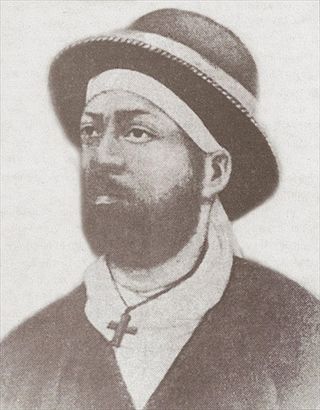
Hailemelekot Sahle Selassie was Negus of Shewa, a historical region of Ethiopia, from 12 October 1847 until his death. He was the oldest son of Negus Sahle Selassie an important Amhara noblemen and his wife Woizero Bezabish Wolde.
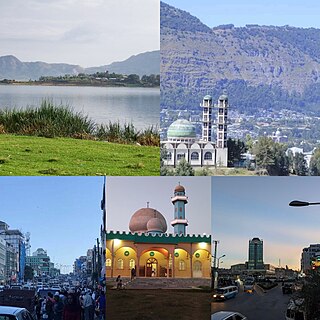
Dessie is a town in north-central Ethiopia. Located in the South Wollo Zone of the Amhara Region, it sits at a latitude and longitude of 11°8′N39°38′E, with an elevation between 2,470 and 2,550 metres above sea level. Dessie is 400 km to the north of the capital Addis Ababa. It has a population of more than 200,000 people in over 30 wards.

Debre Markos is a city, separate woreda, and administrative seat of the East Gojjam Zone in Amhara Region, Ethiopia. It

The Battle of Chelenqo was an engagement fought on 9 January 1887 between the Abyssinian army of Shewa under Negus Menelik and Emir 'Abd Allah II ibn 'Ali 'Abd ash-Shakur of Harar. The Harari forces were routed, and Negus Menelik afterwards occupied and annexed the city of Harar.

The Battle of Segale was a civil conflict in the Ethiopian Empire between the supporters of Empress regent Zewditu and Lij Iyasu on 27 October 1916, and resulted in victory for Zewditu. Paul B. Henze states that "Segale was Ethiopia's greatest battle since Adwa" (1896).

Darge Sahle Selassie, Horse name Abba Gersa, was a 19th-century Ethiopian nobleman, provincial governor, general and a trusted councillor of his nephew Emperor Menelik II.
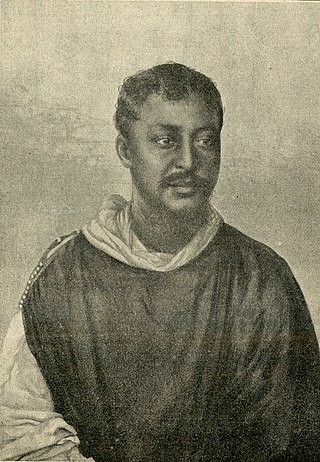
RasMengesha Yohannes was governor of Tigray and a son of Emperor Yohannes IV. His mother was Welette Tekle Haymanot wife of dejazmach Gugsa Mercha. Ras Araya Selassie Yohannes was his younger half brother. Prior to the Battle of Metemma, Mengesha Yohannes was considered to be a nephew of Emperor Yohannes IV. During the battle, the Emperor was mortally wounded and it was on his deathbed that Mengesha Yohannes was acknowledged as his "natural" son and designated as his heir. This created something of a succession problem.
Berehet is one of the woredas in the Amhara Region of Ethiopia. Part of the Semien Shewa Zone, Berehet is bordered on the south by the Germama River which separates it from Menjarna Shenkora, on the west by Hagere Mariamna Kesem, on the north by Asagirt, and on the east by the Afar Region. The major town in Berehet is Metiteh Bila.
Guduru is a woreda in Oromia Region, Ethiopia. This woreda is named after one of the sections of the Macha Oromo, also known as the Torban Guduru, which coalesced into a kingdom around 1855 under Gama Moras, which lay between the Abay River and the Gibe region. It was also the location of the Battle of Embabo, fought 6 June 1882; the Shewan forces of Menelik defeated the Gojjame army, capturing Negus Tekle Haymanot and establishing a Shewan hegemony over the territories south of the Abay.
Meta is one of the districts in the Oromia of Ethiopia. Part of the East Hararghe Zone, Meta is bordered on the southwest by Deder, on the northwest by Goro Gutu, on the north by the Somali Region, on the northeast by Kersa, and on the southeast by Bedeno. Towns in Meta include Chelenqo and Kulubi.

The Battle of Embabo was fought 6 June 1882, between the Shewan forces of Negus Menelik and the Gojjame forces of Negus Tekle Haymanot. The forces fought to gain control over the Oromo areas south of the Gibe River. The Gojjame forces under Tekle Haymanot were defeated. This is one of the three battles which Donald Donham lists that led to Shewan supremacy over the rest of Ethiopia.

Tekle Haymanot Tesema, also known as Adal Tesema, Tekle Haymanot of Gojjam, and Tekle Haimanot of Gojjam, was King of Gojjam. He later was an army commander and a member of the nobility of the Ethiopian Empire.
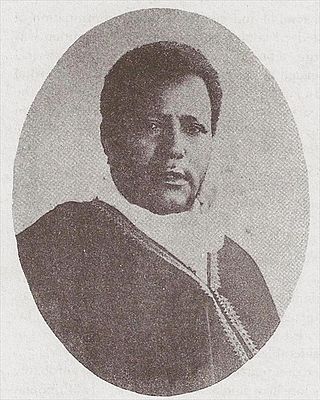
FitawrariHabte Giyorgis Dinagde also known by his horse name Abba Mechal was an Ethiopian military commander and government official who, among several other posts, served as President of the Council of Ministers and as Minister of War during the reigns of Menelik II, Zewditu and Haile Selassie. He was also Shum or Governor of Borena, Ibat, and Mecha.
The Battle of Guté Dili was fought on 14 October 1888 between an alliance of the Shewan forces of Ras Gobana Dacche and Mahdist forces under governor Khalil al-Khuzani near Nejo in the modern Mirab Welega Zone of the Oromia Region, Ethiopia. The Mahdist forces were routed, and only Khalil and Muhammad Hassan of Fadasi, who was leading the Bela Shangul contingent, with a small group of Ansar and Berta soldiers, were able to successfully flee the battlefield.
The Battle of Azule was fought on 6 September 1886, between the forces of Ras Darge Sahle Selassie of Shewa and a force of Arsi Oromo. It was part of a broader series of expansion campaigns done under Menelik II, Negus of Shewa, referred to by some historians as the Agar Maqnat. The battle of Azule was important as it represents the crushing of a large Arsi army by one under Menelik; it also demonstrates the dynamic of gun-wielding Shewans fighting Spear-wielding Arsi that many historians like to stress when discussing Menelik's expansions; it also retains symbolic and historic importance in the politics and identities of many.
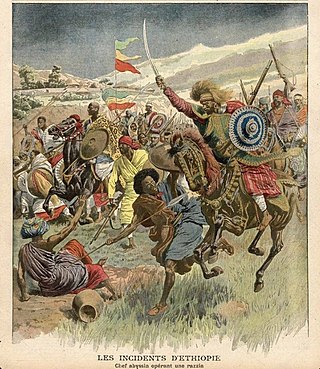
Menelik's conquests, also known as the Agar Maqnat, were a series of expansionist wars and conquests carried out by Emperor Menelik II of Shewa to expand the Ethiopian Empire.
Garmame and Horse name: Abba Mala was an influential 19th century Ethiopian military commander, provincial governor and royal counsellor serving under Negus Sahle Selassie, Haile Melekot and Emperor Menelik II. He held the title of Dejazmach. Garmame is remembered for his leading role in rescuing Menelik II and other notables from captivity in July 1865, and restoring the Shewan heir back to the throne. In May 1877 he prevented a coup concocted by Bafena, and solidified the position of his Negus. After retirement from military activities, Garmame governed large tracts of fertile land south of Ankober, and is also remembered for his role in providing relief to the people during the disastrous 1890's famine'.
Walda Giyorgis was an ecclesiastic during the reign of Menelik II.
References
- ↑ CAULK, R. A. (1975). "Territorial competition and the Battle of Embabo, 1882". Journal of Ethiopian Studies. 13 (1): 65–88. ISSN 0304-2243.